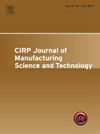Effect of forming parameters on the mechanical properties of clinched joint with rectangle punch
IF 4.6
2区 工程技术
Q2 ENGINEERING, MANUFACTURING
CIRP Journal of Manufacturing Science and Technology
Pub Date : 2024-12-27
DOI:10.1016/j.cirpj.2024.12.008
引用次数: 0
Abstract
The emergence of advanced lightweight materials has not only provided more options for industrial lightweighting, but also imposes higher demands on joining technologies. The clinching process with rectangle punch (CRP) performs well in joining steel or other materials with poor plasticity. In the present paper, AA5182-O sheets were chosen as the research material. The microscopic mechanisms involved in the creation of clinched joints through CRP were examined. An in-depth investigation into the influence of varying forming force, forming speed, and punching angle on the shear strength and failure modes of these joints was conducted. In conclusion, enhancing the forming force positively impacts the shear strength. The failure mode transitions from the separation failure mode to the neck fracture mode. At a forming force of 35 kN, the peak shear strength achieved was 2324 N. The forming speed exhibited minimal influence on the failure mechanism. The orientation of the joint's longer side relative to the shear force direction significantly affects the failure mechanism, when positioned perpendicularly, the shear strength reached the maximum, which was approximately 1.68 times greater compared to a parallel orientation. During the failure process, the interlocking region was subjected to shear force before the neck region and fractured first.
求助全文
约1分钟内获得全文
求助全文
来源期刊

CIRP Journal of Manufacturing Science and Technology
Engineering-Industrial and Manufacturing Engineering
CiteScore
9.10
自引率
6.20%
发文量
166
审稿时长
63 days
期刊介绍:
The CIRP Journal of Manufacturing Science and Technology (CIRP-JMST) publishes fundamental papers on manufacturing processes, production equipment and automation, product design, manufacturing systems and production organisations up to the level of the production networks, including all the related technical, human and economic factors. Preference is given to contributions describing research results whose feasibility has been demonstrated either in a laboratory or in the industrial praxis. Case studies and review papers on specific issues in manufacturing science and technology are equally encouraged.
 求助内容:
求助内容: 应助结果提醒方式:
应助结果提醒方式:


